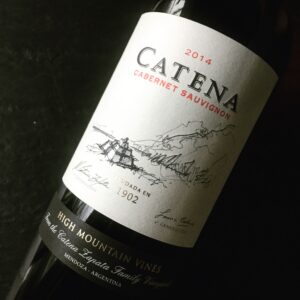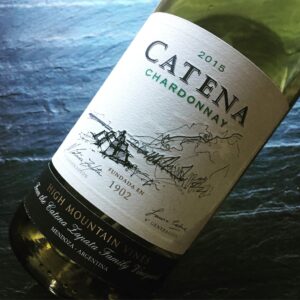What one Argentine winery is doing to combat climate change.
Climate change is everywhere, according to Dr. Laura Catena, and tackling these problems is a race, “We need to look at life at all levels, using science to preserve nature and culture, and we don’t have much time.”
I recently had the opportunity to talk with Dr. Catena about what she and her team at the Catena Institute for Wine are doing to mitigate the effects of climate change. “A lot of what we’re doing now has to do with pruning and cover crops, but in the years ahead that won’t be enough.”
Another strategy involves testing different clonal selections. In 1995, Catena and her team planted the French Malbec clone, Côt Noir in their La Pirámide Vineyard next to vines sourced from their historic 87-year-old Angélica vineyard. By 2003, they were able to confirm that the characteristics of the French clone differed greatly from Argentine Malbec selections. “Lamarck said that as the giraffe’s neck got longer, its offspring would also inherit a longer neck,” she explained.
What Catena is referring to is the work of French naturalist Jean-Baptiste Lamarck, who proposed that organisms, both flora and fauna, pass on traits acquired during their lifetime to their offspring. In the case of the giraffe, a prodigiously long neck allows it to browse the upper canopy with ease—a useful adaptation in a drought-prone climate. It turns out that Lamarkian theory and transgenerational epigenetic inheritance holds true for Vitis vinifera as well.
The Malbec vines brought from France to Argentina in 1853 have since thrived in some of the world’s highest vineyards—a very different terroir and a very different set of stressors as compared with its native Cahors. High altitude plantings receive more sunlight, particularly UV-B radiation, and the vines respond to this damage genetically by producing more antioxidants, and in turn, more phenolic and anthocyanin compounds. Thicker leaves and the accumulation of protective UV-absorbing compounds, including flavonoids in berry skins translate into wines with a darker color, more concentrated flavors, and longer aging potential. In the case of the Côt trial, test vines produced higher yields and clusters with larger berries. The resulting wines were disappointingly rustic.
“We compared our Malbec selections to selections from Europe and the United States,” she continued. “As an experiment, we also planted some ancestral varieties to recover forgotten pre-phylloxera grape varieties. One of the interesting characteristics of these grape varieties is that they are very resistant to drought, which would be a very good advantage in the context of climate change. Some people now think we can take vines from one place—where vines have adapted to withstand water stress—to another region where drought has become an issue. Once that vine is in an environment that no longer has these pressures, the epigenetic changes stay, they don’t disappear.”
But there is another frontier in research that is particularly exciting to Dr. Catena’s team, and it lies in the soil beneath our feet.
The soil microbiome and its cocktail of yeast and bacteria form an invisible network. “Rhizobacteria,” she says, “helps the roots withstand water stress and nutrient uptake. The root gives the bacteria food in exchange for water—this happens in any tree or plant in the forest, and the soil is filled with microbes. The same sort of exchange occurs in human gut bacteria. Finding the right rhizobacteria would be a huge development, and then we could potentially inoculate the vine against water stress, reducing its water use by as much as half. When I think of viticulture, I make my wine, but it’s not a life and death situation—preserving it is important to our culture, but it’s not like we have to have it. We might identify microbes in vines that could be beneficial to other crops.”
Dr. Catena seems to find interconnectedness in everything; our conversation takes unexpected twists and turns, and we chat briefly about her work as a physician in San Francisco, where she spends six days per month in the pediatric emergency care unit. “Sometimes I think about whether I should continue or stop. Sometimes I’m really tired at the end of the day,” she confesses. “But, you only live once—the hospital, I love going there, it’s so interesting and being a doctor has this aspect to it that is instantly rewarding. It goes back to our earlier discussion, what you do with your time. When people don’t have their health they don’t have anything.”

The studies that take place over years in her semi-arid vineyards move at a glacial pace compared to the fast pace of the emergency room. For the moment, Dr. Catena seems to be finding the balance in her split endeavors. “I just read the most incredible article about a group at Harvard, where they found bacteria that can degrade the plastic in the oceans, then yet another family of bacteria that then metabolizes the by-products of the plastic once it’s been broken down. We need to bring this kind of creativity to all the research we do.”
The Catena Institute is working on a number of different studies to with a goal of creating quality wines from sustainable terroirs for the next 100 years. “One of the tragedies in Mendoza is that the whole area that produced table wines in the East has shifted, that’s not a successful story for me,” admits Catena. “All of the people in the East are now poor; we want to bring viticulture back to that region. Right now we’re trying to cultivate an interest in varieties that were grown in our country for centuries, but have not found a place in the market. Bonarda is one such example, where we’re using science and marketing to revitalize the region.”
“I judge a place by their gardens. If there are flowers, people are happy. You can tell when people are doing well; there are coffee shops, and restaurants, and this wonderful vibrancy. If I can bring more prosperity to the region, my impact is larger as a winegrower than as a physician.”
Tasting Notes
Bodega Catena Zapata Cabernet Sauvignon High Mountain Vines 2014
 Alive with glorious aromas of black currant, anise, mocha, exotic spice, and cedar. Medium weight, elevation has endowed this Argentine Cab with elegance and silkiness stitched against a backdrop of fine tannins and high acidity. It’s fresh and intense with a finish dipped in saline-edged minerality. 13.5% ABV | Sample
Alive with glorious aromas of black currant, anise, mocha, exotic spice, and cedar. Medium weight, elevation has endowed this Argentine Cab with elegance and silkiness stitched against a backdrop of fine tannins and high acidity. It’s fresh and intense with a finish dipped in saline-edged minerality. 13.5% ABV | Sample
Bodega Catena Zapata Chardonnay High Mountain Vines 2015
 Catena’s High Mountain Vines Chardonnay is sourced from three vineyard sites, ranging from 3,100-4,757′ in altitude, hence the name. The soils are predominantly gravelly or stony, and all of these sites are cool climate—these factors are reflected in the profile of this fresh and restrained Argentine Chard. Acacia honey, lemon blossom, pear and citrus round out the nose. In the mouth, it’s balanced and lean with slightly underripe white peach at the core and and a lithe saline-mineral flourish on the finish. 13.5% ABV | Sample
Catena’s High Mountain Vines Chardonnay is sourced from three vineyard sites, ranging from 3,100-4,757′ in altitude, hence the name. The soils are predominantly gravelly or stony, and all of these sites are cool climate—these factors are reflected in the profile of this fresh and restrained Argentine Chard. Acacia honey, lemon blossom, pear and citrus round out the nose. In the mouth, it’s balanced and lean with slightly underripe white peach at the core and and a lithe saline-mineral flourish on the finish. 13.5% ABV | Sample
